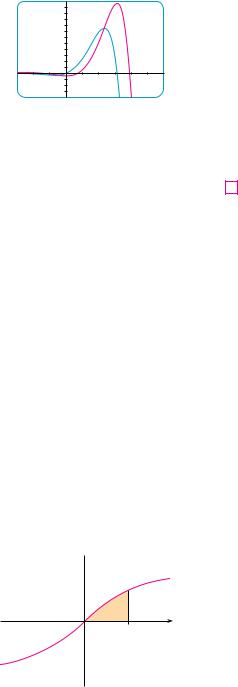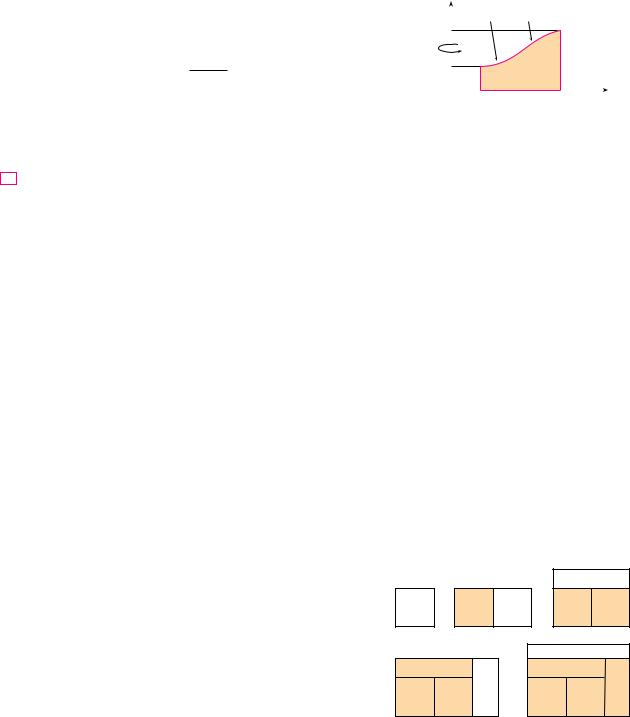
- •CONTENTS
- •Preface
- •To the Student
- •Diagnostic Tests
- •1.1 Four Ways to Represent a Function
- •1.2 Mathematical Models: A Catalog of Essential Functions
- •1.3 New Functions from Old Functions
- •1.4 Graphing Calculators and Computers
- •1.6 Inverse Functions and Logarithms
- •Review
- •2.1 The Tangent and Velocity Problems
- •2.2 The Limit of a Function
- •2.3 Calculating Limits Using the Limit Laws
- •2.4 The Precise Definition of a Limit
- •2.5 Continuity
- •2.6 Limits at Infinity; Horizontal Asymptotes
- •2.7 Derivatives and Rates of Change
- •Review
- •3.2 The Product and Quotient Rules
- •3.3 Derivatives of Trigonometric Functions
- •3.4 The Chain Rule
- •3.5 Implicit Differentiation
- •3.6 Derivatives of Logarithmic Functions
- •3.7 Rates of Change in the Natural and Social Sciences
- •3.8 Exponential Growth and Decay
- •3.9 Related Rates
- •3.10 Linear Approximations and Differentials
- •3.11 Hyperbolic Functions
- •Review
- •4.1 Maximum and Minimum Values
- •4.2 The Mean Value Theorem
- •4.3 How Derivatives Affect the Shape of a Graph
- •4.5 Summary of Curve Sketching
- •4.7 Optimization Problems
- •Review
- •5 INTEGRALS
- •5.1 Areas and Distances
- •5.2 The Definite Integral
- •5.3 The Fundamental Theorem of Calculus
- •5.4 Indefinite Integrals and the Net Change Theorem
- •5.5 The Substitution Rule
- •6.1 Areas between Curves
- •6.2 Volumes
- •6.3 Volumes by Cylindrical Shells
- •6.4 Work
- •6.5 Average Value of a Function
- •Review
- •7.1 Integration by Parts
- •7.2 Trigonometric Integrals
- •7.3 Trigonometric Substitution
- •7.4 Integration of Rational Functions by Partial Fractions
- •7.5 Strategy for Integration
- •7.6 Integration Using Tables and Computer Algebra Systems
- •7.7 Approximate Integration
- •7.8 Improper Integrals
- •Review
- •8.1 Arc Length
- •8.2 Area of a Surface of Revolution
- •8.3 Applications to Physics and Engineering
- •8.4 Applications to Economics and Biology
- •8.5 Probability
- •Review
- •9.1 Modeling with Differential Equations
- •9.2 Direction Fields and Euler’s Method
- •9.3 Separable Equations
- •9.4 Models for Population Growth
- •9.5 Linear Equations
- •9.6 Predator-Prey Systems
- •Review
- •10.1 Curves Defined by Parametric Equations
- •10.2 Calculus with Parametric Curves
- •10.3 Polar Coordinates
- •10.4 Areas and Lengths in Polar Coordinates
- •10.5 Conic Sections
- •10.6 Conic Sections in Polar Coordinates
- •Review
- •11.1 Sequences
- •11.2 Series
- •11.3 The Integral Test and Estimates of Sums
- •11.4 The Comparison Tests
- •11.5 Alternating Series
- •11.6 Absolute Convergence and the Ratio and Root Tests
- •11.7 Strategy for Testing Series
- •11.8 Power Series
- •11.9 Representations of Functions as Power Series
- •11.10 Taylor and Maclaurin Series
- •11.11 Applications of Taylor Polynomials
- •Review
- •APPENDIXES
- •A Numbers, Inequalities, and Absolute Values
- •B Coordinate Geometry and Lines
- •E Sigma Notation
- •F Proofs of Theorems
- •G The Logarithm Defined as an Integral
- •INDEX

7.1 INTEGRATION BY PARTS
Every differentiation rule has a corresponding integration rule. For instance, the Substitution Rule for integration corresponds to the Chain Rule for differentiation. The rule that corresponds to the Product Rule for differentiation is called the rule for integration by parts.
The Product Rule states that if f and t are differentiable functions, then
|
|
d |
f x t x f x t x t x f x |
|
|
|
|
|
|
dx |
|
In the notation for indefinite integrals this equation becomes |
|||
|
y f x t x t x f x dx f x t x |
||
or |
yf x t x dx yt x f x dx f x t x |
||
We can rearrange this equation as |
|||
|
|
||
1 |
yf x t x dx f x t x yt x f x dx |
||
|
|
|
|
Formula 1 is called the formula for integration by parts. It is perhaps easier to remember in the following notation. Let u f x and v t x . Then the differentials are du f x dx and dv t x dx, so, by the Substitution Rule, the formula for integration by parts becomes
2 |
|
yu dv uv yv du |
|
|
|
|
|
EXAMPLE 1 Find yx sin x dx. |
|||
SOLUTION USING FORMULA 1 |
Suppose we choose f x x and t x sin x. Then f x 1 |
||
and t x cos x. (For t we can choose any antiderivative of t .) Thus, using Formula 1, we have
yx sin x dx f x t x yt x f x dx
x cos x y cos x dx
x cos x ycos x dx
x cos x sin x C
It’s wise to check the answer by differentiating it. If we do so, we get x sin x, as expected.
453

454 |||| CHAPTER 7 TECHNIQUES OF INTEGRATION
N It is helpful to use the pattern:
u |
dv |
du |
v |
SOLUTION USING FORMULA 2 Let |
|
|
|
|
u x |
dv sin x dx |
|
Then |
du dx |
v cos x |
|
and so |
|
|
|
|
u d√ |
u √ |
√ du |
|
yx sin x dx y x sin x dx x cos x y cos x dx |
||
|
x cos x ycos x dx |
|
|
|
x cos x sin x C |
M |
|
NIt’s customary to write x1 dx as xdx.
NCheck the answer by differentiating it.
NOTE Our aim in using integration by parts is to obtain a simpler integral than the one we started with. Thus in Example 1 we started with xx sin x dx and expressed it in terms of the simpler integral xcos x dx. If we had instead chosen u sin x and dv x dx, then du cos x dx and v x2 2, so integration by parts gives
yx sin x dx sin x |
x2 |
|
1 |
yx2 cos x dx |
2 |
2 |
Although this is true, xx2 cos x dx is a more difficult integral than the one we started with. In general, when deciding on a choice for u and dv, we usually try to choose u f x to be a function that becomes simpler when differentiated (or at least not more complicated) as long as dv t x dx can be readily integrated to give v.
V EXAMPLE 2 Evaluate yln x dx.
SOLUTION Here we don’t have much choice for u and dv. Let
|
u ln x |
dv dx |
|||
Then |
du |
1 |
dx |
v x |
|
x |
|||||
|
|
|
|
||
Integrating by parts, we get
yln x dx x ln x yx dxx
x ln x ydx
x ln x x C
Integration by parts is effective in this example because the derivative of the function f x ln x is simpler than f. M

N An easier method, using complex numbers, is given in Exercise 50 in Appendix H.
SECTION 7.1 INTEGRATION BY PARTS |||| 455
V EXAMPLE 3 Find yt2et dt.
SOLUTION Notice that t2 becomes simpler when differentiated (whereas et is unchanged when differentiated or integrated), so we choose
|
u t2 |
dv et |
dt |
Then |
du 2t dt |
v et |
|
Integration by parts gives |
|
|
|
3 |
yt2et dt t2et 2 ytet dt |
||
The integral that we obtained, xtet dt, is simpler than the original integral but is still not obvious. Therefore, we use integration by parts a second time, this time with u t and dv et dt. Then du dt, v et, and
ytet dt tet yet dt tet et C
Putting this in Equation 3, we get
yt 2et dt t2et 2 ytet dt
t2et 2 tet et C
t2et 2tet 2et C1 where C1 2C |
M |
V EXAMPLE 4 Evaluate yex sin x dx.
SOLUTION Neither ex nor sin x becomes simpler when differentiated, but we try choosing u ex and dv sin x dx anyway. Then du ex dx and v cos x, so integration by parts gives
4 |
yex sin x dx ex cos x yex cos x dx |
The integral that we have obtained, xex cos x dx, is no simpler than the original one, but at least it’s no more difficult. Having had success in the preceding example integrating by parts twice, we persevere and integrate by parts again. This time we use u ex and dv cos x dx. Then du ex dx, v sin x, and
5 |
yex cos x dx ex sin x yex sin x dx |
At first glance, it appears as if we have accomplished nothing because we have arrived at xex sin x dx, which is where we started. However, if we put the expression for xex cos x dx from Equation 5 into Equation 4 we get
yex sin x dx ex cos x ex sin x yex sin x dx

456 |||| CHAPTER 7 TECHNIQUES OF INTEGRATION
N Figure 1 illustrates Example 4 by show-
ing the graphs of f x e x sin x and
F x 12 e x sin x cos x . As a visual check on our work, notice that f x 0 when F has a maximum or minimum.
12
This can be regarded as an equation to be solved for the unknown integral. Adding xex sin x dx to both sides, we obtain
2 yex sin x dx ex cos x ex sin x
F
f
_3 |
6 |
_4
FIGURE 1
N Since tan 1x 0 for x 0, the integral in Example 5 can be interpreted as the area of the region shown in Figure 2.
y
y=tan–!x
0
1 x
FIGURE 2
Dividing by 2 and adding the constant of integration, we get
yex sin x dx 21 ex sin x cos x C |
M |
If we combine the formula for integration by parts with Part 2 of the Fundamental Theorem of Calculus, we can evaluate definite integrals by parts. Evaluating both sides of Formula 1 between a and b, assuming f and t are continuous, and using the Fundamental Theorem, we obtain
6
EXAMPLE 5
SOLUTION Let
Then
|
b |
|
|
b |
b |
|
ya |
f x t x dx f x t x ]a |
ya t x f x dx |
||
|
|
|
|
|
|
1 |
|
|
|
|
|
Calculate y0 |
tan 1x dx. |
|
|
|
|
|
|
u tan 1x |
dv dx |
||
|
|
du |
dx |
v x |
|
|
|
|
|
||
|
|
1 x2 |
|||
So Formula 6 gives
1 |
|
|
1 |
1 |
|
|
x |
|
|
|
|
y0 tan 1x dx x tan 1x]0 |
y0 |
|
|
dx |
|
|
|||||
|
1 x2 |
|
|
||||||||
|
|
|
|
|
|
|
|
1 |
x |
||
1 tan 1 |
1 0 tan 1 |
0 y0 |
|
dx |
|||||||
1 x2 |
|||||||||||
|
1 |
|
x |
|
|
|
|
|
|
||
|
|
y0 |
|
|
|
dx |
|
|
|
|
|
4 |
1 x2 |
|
|
|
|
|
|||||
To evaluate this integral we use the substitution t 1 x2 (since u has another meaning in this example). Then dt 2x dx, so x dx 12 dt. When x 0, t 1; when x 1,
t 2; so
|
1 x |
|
|
2 dt |
2 |
|
|
|
|
|||||
|
y0 |
|
dx 21 y1 |
|
|
21 ln t ]1 |
|
|
|
|
||||
|
1 x2 |
t |
|
|
|
|
||||||||
|
|
|
|
|
21 ln 2 ln 1 21 ln 2 |
|
|
|||||||
|
1 |
|
|
|
1 |
|
x |
|
|
|
ln 2 |
|
||
Therefore |
y0 tan 1x dx |
|
y0 |
|
|
|
dx |
|
|
|
|
M |
||
4 |
1 x2 |
4 |
|
2 |
||||||||||

SECTION 7.1 INTEGRATION BY PARTS |||| 457
EXAMPLE 6 Prove the reduction formula
N Equation 7 is called a reduction formula |
|
|
ysin |
|
|
1 |
|
|
|
|
|
n 1 |
ysin |
|
|
|
|||||
because the exponent n has been reduced to |
|
|
n |
|
|
|
n 1 |
|
|
n 2 |
|
|
|||||||||
|
|
|
|
|
|
|
|
|
|
|
|
|
|
|
|||||||
7 |
|
x dx n cos x sin |
x |
|
n |
x dx |
|
||||||||||||||
n 1 and n 2. |
|
|
|
|
|
|
|||||||||||||||
|
where n 2 is an integer. |
|
|
|
|
|
|
|
|
|
|
|
|
|
|
|
|
||||
|
SOLUTION |
Let |
u sinn 1x |
|
|
|
|
|
|
|
|
|
dv sin x dx |
|
|||||||
|
Then |
|
du n 1 sinn 2x cos x dx |
|
v cos x |
|
|||||||||||||||
|
so integration by parts gives |
|
|
|
|
|
|
|
|
|
|
|
|
|
|
|
|
||||
|
|
|
ysinnx dx cos x sinn 1x n 1 ysinn 2x cos2x dx |
|
|||||||||||||||||
|
Since cos2x 1 sin2x, we have |
|
|
|
|
|
|
|
|
|
|
|
|||||||||
|
|
ysinnx dx cos x sinn 1x n 1 ysinn 2x dx n 1 ysinnx dx |
|
||||||||||||||||||
|
As in Example 4, we solve this equation for the desired integral by taking the last term |
|
|||||||||||||||||||
|
on the right side to the left side. Thus we have |
|
|
|
|
|
|
|
|
|
|
||||||||||
|
|
|
n ysinnx dx cos x sinn 1x n 1 ysinn 2x dx |
|
|||||||||||||||||
|
or |
|
ysinnx dx |
1 |
cos x sinn 1x |
|
n 1 |
|
ysinn 2x dx |
|
|||||||||||
|
|
|
|
|
|
|
|
|
M |
||||||||||||
|
|
n |
|
n |
|
||||||||||||||||
The reduction formula (7) is useful because by using it repeatedly we could eventually express xsinnx dx in terms of xsin x dx (if n is odd) or x sin x 0 dx xdx (if n is even).
7.1E X ER C I S E S
1–2 Evaluate the integral using integration by parts with the indicated choices of u and dv.
1. |
yx 2 ln x dx; u ln x, dv x 2 dx |
||
2. |
y cos d ; u , |
dv cos d |
|
|
|
|
|
3–32 Evaluate the integral. |
|
|
|
3. |
yx cos 5x dx |
4. |
yxe x dx |
5. |
yrer 2 dr |
6. |
yt sin 2t dt |
7. |
yx 2 sin x dx |
8. |
yx 2 cos mx dx |
9. |
yln 2x 1 dx |
10. |
ysin 1x dx |
11. |
yarctan 4t dt |
||
13. |
yt sec2 2t dt |
||
|
y ln x 2 dx |
||
15. |
|||
|
|||
|
ye 2 sin 3 d |
||
17. |
|||
|
|||
|
|
|
|
19. |
y0 |
t sin 3t dt |
|
|
1 |
|
|
21. |
y0 |
t cosh t dt |
|
|
2 |
ln x |
|
23. |
y1 |
|
dx |
x 2 |
|||
12.yp5 ln p dp
14.ys 2s ds
16. |
yt sinh mt dt |
|||||
18. |
ye cos 2 d |
|||||
|
|
1 |
|
|
|
|
|
20. |
y0 |
x 2 1 e x dx |
|||
|
||||||
|
|
9 |
ln y |
|||
22. |
y4 |
|
|
|
dy |
|
s |
|
|
||||
y |
||||||
|
|
|
|
|
|
|
24. |
y0 |
x 3 cos x dx |
||||

458 |
|||| |
CHAPTER 7 |
TECHNIQUES OF INTEGRATION |
|||||||||
|
|
1 |
y |
|
s3 |
|||||||
25. |
y0 |
|
dy |
26. |
y1 |
|
arctan 1 x dx |
|||||
e2y |
|
|||||||||||
|
|
1 2 |
|
2 |
|
ln x 2 |
||||||
27. |
y0 |
cos 1x dx |
28. |
y1 |
|
|
|
dx |
||||
|
|
x 3 |
||||||||||
|
|
|
|
|
|
1 |
|
|
r 3 |
|||
29. |
ycos x ln sin x dx |
30. |
y0 |
|
|
|
|
|
dr |
|||
|
s |
|
|
|
||||||||
|
4 r 2 |
|||||||||||
|
|
2 |
|
|
|
t |
|
|
|
|
|
|
31. |
y1 |
x 4 ln x 2 dx |
32. |
y0 |
e s sin t s ds |
|||||||
|
|
|
|
|
|
|
|
|
|
|
|
|
33–38 First make a substitution and then use integration by parts to evaluate the integral.
33. |
ycos s |
x |
dx |
|
|
34. |
yt 3e t2 dt |
|||||||||
|
|
s |
|
|
|
|
|
|
|
|
|
|
|
|
|
|
|
|
|
|
|
3 |
|
|
2 |
|
|
cos t |
|
||||
|
35. |
ys |
|
|
|
|
cos |
|
d |
36. |
y0 e |
|
sin 2t dt |
|||
|
2 |
|
|
|
|
|
||||||||||
37. |
yx ln 1 x dx |
38. |
ysin ln x dx |
|||||||||||||
|
|
|
|
|
|
|
|
|
|
|
|
|
|
|
|
|
;39– 42 Evaluate the indefinite integral. Illustrate, and check that your answer is reasonable, by graphing both the function and its antiderivative (take C 0).
39. |
y 2x 3 e x dx |
40. |
yx 3 2 ln x dx |
||
41. |
yx 3s |
|
dx |
42. |
yx 2 sin 2x dx |
1 x 2 |
|||||
|
|
|
|
|
|
43. (a) Use the reduction formula in Example 6 to show that
ysin2x dx |
x |
|
sin 2x |
C |
2 |
4 |
(b) Use part (a) and the reduction formula to evaluate xsin4x dx.
44.(a) Prove the reduction formula
1 |
|
n 1 |
|
|
ycosnx dx |
|
cosn 1x sin x |
|
ycosn 2x dx |
n |
n |
|||
(b)Use part (a) to evaluate xcos2x dx.
(c)Use parts (a) and (b) to evaluate xcos4x dx.
45.(a) Use the reduction formula in Example 6 to show that
2 |
n 1 |
2 |
y0 sinnx dx |
|
y0 sinn 2x dx |
n |
where n 2 is an integer.
|
|
|
|
|
(b) Use part (a) to evaluate x0 2 sin3x dx and x0 2 sin5x dx. |
||||
(c) Use part (a) to show that, for odd powers of sine, |
||||
2 |
|
2 4 6 |
2n |
|
|
|
|
|
|
y0 |
sin2n 1x dx |
|
|
|
3 5 7 |
2n 1 |
|||
46. Prove that, for even powers of sine,
2 |
1 3 5 |
2n 1 |
|
|
|
|
|
|
|
y0 sin2nx dx |
|
|
|
|
2 4 6 |
2n |
2 |
||
47–50 Use integration by parts to prove the reduction formula.
47.y ln x n dx x ln x n n y ln x n 1 dx
48.yx ne x dx x ne x n yx n 1e x dx
|
|
tann 1 x |
|
|
|
|
|
||
49. |
tann x dx |
|
ytann 2 x dx |
|
n 1 |
|
|||
n 1 |
|
|
|||||||
50. |
ysecnx dx |
tan x secn 2x |
|
n |
2 |
ysecn 2x dx |
n 1 |
||
n 1 |
n |
1 |
|||||||
|
|
|
|
|
|
|
|
|
|
51.Use Exercise 47 to find x ln x 3 dx.
52.Use Exercise 48 to find xx 4e x dx.
53–54 Find the area of the region bounded by the given curves.
53. |
y xe 0.4x, |
y 0, x 5 |
54. |
y 5 ln x, |
y x ln x |
|
|
|
;55–56 Use a graph to find approximate x-coordinates of the points of intersection of the given curves. Then find (approximately) the area of the region bounded by the curves.
55. |
y x sin x, |
y x 2 2 |
56. |
y arctan 3x, |
y 21 x |
|
|
|
57–60 Use the method of cylindrical shells to find the volume generated by rotating the region bounded by the given curves about the specified axis.
57. |
y cos x 2 , |
y 0, 0 x 1; about the y-axis |
|
58. |
y e x, y e x, x 1; |
about the y-axis |
|
59. |
y e x, y 0, |
x 1, |
x 0; about x 1 |
60. |
y e x, x 0, |
y ; |
about the x-axis |
|
|
|
|

61. Find the average value of f x x 2 ln x on the interval 1, 3 .
62.A rocket accelerates by burning its onboard fuel, so its mass decreases with time. Suppose the initial mass of the rocket at liftoff (including its fuel) is m, the fuel is consumed at rate r, and the exhaust gases are ejected with constant velocity ve (relative to the rocket). A model for the velocity of the rocket at time t is given by the equation
m rt
v t tt ve ln
m
where t is the acceleration due to gravity and t is not too large. If t 9.8 m s2, m 30,000 kg, r 160 kg s, and ve 3000 m s, find the height of the rocket one minute after liftoff.
63. A particle that moves along a straight line has velocity
v t t 2e t meters per second after t seconds. How far will it travel during the first t seconds?
64. |
If f 0 t 0 0 and f and t are continuous, show that |
|
|
a |
a |
|
y0 |
f x t x dx f a t a f a t a y0 f x t x dx |
65. |
Suppose that f 1 2, f 4 7, f 1 5, f 4 3, and |
|
|
f is continuous. Find the value of x14 xf x dx. |
|
|
(a) Use integration by parts to show that |
|
66. |
||
yf x dx xf x yxf x dx
(b)If f and t are inverse functions and f is continuous, prove that
b |
f b |
ya |
f x dx bf b af a yf a t y dy |
[Hint: Use part (a) and make the substitution y f x .]
(c)In the case where f and t are positive functions and
b a 0, draw a diagram to give a geometric interpretation of part (b).
(d)Use part (b) to evaluate x1e ln x dx.
67. We arrived at Formula 6.3.2, V xab 2 x f x dx, by using cylindrical shells, but now we can use integration by parts to prove it using the slicing method of Section 6.2, at least for the case where f is one-to-one and therefore has an inverse function t. Use the figure to show that
V b 2d a 2c yd t y 2 dy
c
SECTION 7.1 INTEGRATION BY PARTS |||| 459
parts on the resulting integral to prove that
|
|
b |
|
|
|
|
|
V ya |
2 x f x dx |
|
|
||
y |
x=g(y) |
y=ƒ |
|
|
||
|
|
|
||||
d |
|
|
|
|
|
|
c |
|
|
|
|
x=b |
|
x=a |
|
|
|
|
||
|
|
|
|
|
||
|
|
|
|
|
|
|
0 |
a |
b |
x |
|||
|
|
|
|
|
|
|
68.Let In x0 2 sinnx dx.
(a)Show that I2n 2 I2n 1 I2n .
(b)Use Exercise 46 to show that
|
|
|
|
|
|
|
|
|
|
I2n 2 |
|
2n 1 |
|
|
|
|
|
||||||||||
|
|
|
|
|
|
|
|
|
|
|
2n 2 |
|
|
|
|
||||||||||||
|
|
|
|
|
|
|
|
|
|
I2n |
|
|
|
|
|
|
|
|
|
||||||||
(c) Use parts (a) and (b) to show that |
|
|
|
|
|||||||||||||||||||||||
|
|
|
|
|
|
|
|
2n 1 |
|
|
I2n 1 |
1 |
|
|
|
|
|||||||||||
|
|
|
|
|
|
|
|
|
|
|
|
|
|
|
|
||||||||||||
|
|
|
|
|
|
|
|
2n 2 |
|
|
|
I2n |
|
|
|
|
|||||||||||
and deduce that limn l I2n 1 I2n 1. |
|
|
|
|
|||||||||||||||||||||||
(d) Use part (c) and Exercises 45 and 46 to show that |
|
|
|||||||||||||||||||||||||
lim |
2 |
|
2 |
|
4 |
|
4 |
|
|
6 |
|
|
6 |
|
|
|
|
2n |
|
2n |
|
|
|||||
|
|
|
|
|
|
|
|
|
|
2 |
|||||||||||||||||
n l 1 |
3 |
3 |
5 |
5 |
|
7 |
|
|
|
|
|
2n 1 2n 1 |
|
||||||||||||||
This formula is usually written as an infinite product:
|
|
2 |
|
2 |
|
4 |
|
4 |
|
6 |
|
6 |
|
2 |
|
|
|
|
|
|
|||||||
1 |
3 |
3 |
5 |
5 |
7 |
|
|||||||
and is called the Wallis product.
(e)We construct rectangles as follows. Start with a square of area 1 and attach rectangles of area 1 alternately beside or on top of the previous rectangle (see the figure). Find the
limit of the ratios of width to height of these rectangles.
Make the substitution y f x and then use integration by
